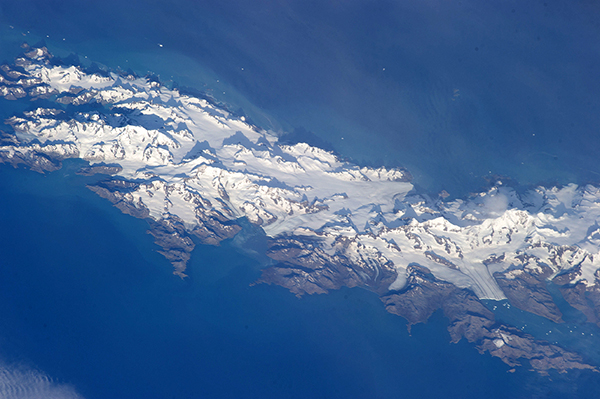
by Claire Hepper Monday, September 9, 2013

The mountainous spine of South Georgia Island is the Allardyce Range, a displaced fragment of the Andes of southernmost South America. New research suggests such a volcanic island arc blocked the Antarctic Circumpolar Current from forming until 12 million years ago. NASA
There has long been a debate in the geological community over what caused the formation of the Antarctic ice sheet during the Eocene-Oligocene period about 30 million years ago. One of the widely accepted hypotheses is that the glaciation was triggered by the commencement of the Antarctic Circumpolar Current (ACC), an ocean current that circles Antarctica insulating the continent from the warm waters to the north, allowing the ice sheet to remain relatively stable. However, a new study in Geology may invalidate this hypothesis.
Ian Dalziel, a geologist at the University of Texas at Austin, and his team initially set out to study the seafloor magnetic anomalies in the middle of the Scotia Sea, which lies between the South American and Antarctic plates. Using multibeam sonar to map the bathymetry of the seafloor, the team identified bathymetric highs in the Central Scotia Sea, which did not appear to be part of the seafloor.
To determine the nature of the rises, the team dredged seafloor samples, which revealed the chemical composition, not of typical seafloor basalts, but rather of island arc volcanics.
Furthermore, the samples were found to be chemically similar to the South Sandwich Island Arc, a currently active volcanic arc located in the East Scotia Sea. Based on these geochemical similarities, Dalziel’s team named the newly discovered feature the Ancestral South Sandwich Arc.
Argon isotopic analysis dated the samples to between 28 million and 12 million years old. However, the authors suggested the arc was possibly active earlier, as the samples were collected from the tops of the rises and younger volcanic material would be closest to the surface.
The researchers proposed that this arc would have blocked the flow of the ACC until the mid-Miocene, roughly 12 million years ago. With the ACC blocked until 18 million years after the onset of glaciation in Antarctica, it could not have been the cause of the glaciation, they wrote. However, they noted, the ACC may have caused the more extensive glaciation that began about 12 million years ago, when the island arc would have been eroding.
The work is a “very elegant combination of solid earth geology and geophysics with studies of climate systems,” says Slawek Tulaczyk, a geologist at the University of California at Santa Cruz who was not involved with the study. The study’s conclusions are well-formed based on the data available, he says. However, he notes, it is difficult to determine how high a feature was with respect to former sea levels, so it would be challenging to know exactly how high above sea level the arc protruded and thus to what extent the ACC was blocked.
Further research is needed, Dalziel notes, but with the ACC looking like an unlikely explanation for initial Antarctic glaciation, another hypothesis — that declining levels of atmospheric carbon dioxide triggered a global cooling about 30 million years ago — may now take the lead.
© 2008-2021. All rights reserved. Any copying, redistribution or retransmission of any of the contents of this service without the expressed written permission of the American Geosciences Institute is expressly prohibited. Click here for all copyright requests.